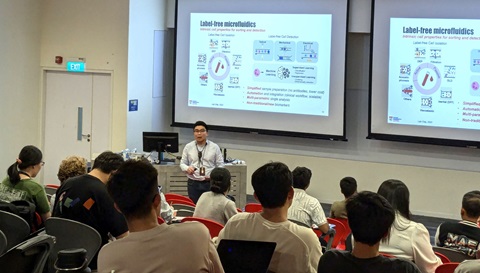Can 3D Printing Print Cells in Our Body? by Prof Paulo Bartolo
IAS Discovery Science Seminar Jointly Organised with the Graduate Students' Clubs
Prof Paulo Bartolo gave an enlightening talk "Can 3D Printing Print Cells in Our Body?" on 2 November 2023 at the Arc LT. The Discovery Science Seminar was jointly organised by IAS NTU and the Graduate Students’ Clubs of MAE, SBS, and LKCMedicine.
Prof Paulo Bartolo is currently the Executive Director of the Singapore Centre for 3D Printing (SC3DP) and also the Programme Director of the National Additive Manufacturing Innovation Cluster Hub in NTU. His impactful journey encompasses diverse milestones, such as the former Chair Professor on Advanced Manufacturing and the Industry 4.0 Academic Lead at the University of Manchester, as well as the Founding Director of the Centre for Rapid and Sustainable Product Development at the Polytechnic Institute of Leiria, Portugal. He has been advisor/reviewer for several global funding agencies, such as the European Research Council and the Medical Research Council (MRC, UK).
Recognised as one of the Top 2% Scientists Worldwide by Stanford University and Elsevier, he is also considered by Microsoft Academic as the most salient author worldwide in the biomanufacturing field and among the Top 100 most salient author worldwide in the field of tissue engineering.

Prof Bartolo introducing the Singapore Centre for 3D Printing (left) and sharing the potential of 3D printing in biomedical applications.
While 3D printing is more commonly used to print metal, polymeric, ceramic, and composite components for applications in aerospace and automotive, Prof Bartolo showed the potential of 3D printing in another domain of biomedical applications.
Starting with the scaffold-based approach, Prof Bartolo showed how 3D printing can be utilised for customisable biomedical devices such as orthopedic prostheses and orthoses required in patients with missing portions in their skulls or bones. He shared several examples based on his earlier work as the Advisor of the Brazilian Institute of Biofabrication.
Other than the design aspect, the process of 3D printing can be combined with rotational electrospinning to create a dual-scale scaffold for bone tissue regeneration. Furthermore, using a combination of different biocompatible and biodegradable materials, 3D-printed scaffolds with dual function can be fabricated for bone cancer treatment. It is implanted at the site where the bone tumor was previously removed to induce death of the remaining cancer cells (treatment phase), and also to recruit healthy cells for new bone formation (regeneration phase). Prof Bartolo also briefly illustrated the potential of incorporating machine learning to help with the reduction of time-consuming tests required before these 3D-printed samples could be used in humans.

Despite these outstanding results, 3D-printed scaffold-based tissue engineering is limited by the compulsory surface treatment of these samples from hydrophobic to hydrophilic, which is important for cells. Although it is possible to resolve this problem,
it would be easier to go for a cell-based approach. Prof Bartolo proved that this is achievable through 3D printing of cell-laden hydrogels, where extensive research is being done on bioink. One example of bioprinting was the pectin-based bioink containing
cells, which incorporate ionic gelation and thiol-ene reactions to control the rheology (important for shape fidelity) and tailoring the biochemical and mechanical properties (important for cell adhesion and proliferation), respectively. After
optimisation, these bioinks can be printed directly into the human body as seen in the robotic in situ bioprinting for cartilage regeneration.
While non-vascular tissues like cartilage are possible through bioprinting, most of the human tissues are vascularised (meaning it contains blood vessels) which makes bioprinting of larger organs like liver still challenging. Prof Bartolo showed his group’s current research to overcome this problem through redesigning the 3D printers to allow bioinks to be deposited in tubular structures mimicking actual vascularised tissues, done in collaboration with a well-known company CELLLINK. Prof Bartolo assured the audience that the future of 3D printing directly into our human bodies is near, with the first application being bioprinting of skin in patients.
After the presentation, Prof Bartolo addressed many questions from the audience such as the choice of material in 3D-printed scaffolds, the experimental procedure involving sterilisation, as well as the benefits and limitations of bioprinting.

"Interesting topic and high end technology." - Wang Fan (PhD student, SCSE)
"New insights about the interdisciplinary research and specifically the expertise needed for 3D bioprinting." - Kevin Matthew Manurung (PhD student, IGP-NEWRI)
"The question about the potential strategy of tissue engineering for tissue repair was interesting." - Ju Wei (PhD student, LKCMedicine)
"I like that a wide range of examples of real world applications were given and well explained."- Sun Qinglu (Master student, MSE)
Written by Slocha Sapasakulvanit |MAE GSC







